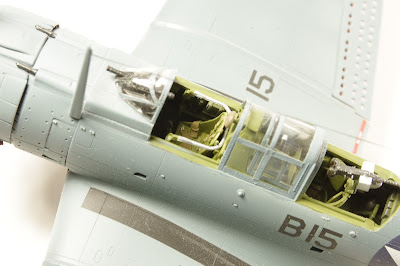Unfortunately - or fortunately depending on how you look at it - I have a fair number of decals still in kits as well as aftermarket decals that are getting old enough to be of doubtful quality. That means I must test each sheet I am going to use by picking a decal I am not going to use on a model, dipping it in water, and applying it to a “paint dummy” model. My “paint dummies” are models I was not going to build for display for whatever reason. I have assembled the major parts, and I use them to try new paints and paint schemes, and I use them to apply decals to see if they are still viable. After I am done, they are sprayed again with Vallejo Surface Primer and await their next “mission”.
Before I proceeded too far with this Spitfire, I selected a few decals from the Aeromaster sheet I was not going to use, and I applied them. Luckily, they worked as one would hope. So, construction went ahead as planned.

I selected a machine from 121 Squadron. Here is a photo of three 121 Squadron machines landing after a raid over occupied France. The story of the Eagle Squadrons makes you proud to be an American. Wikipedia has an excellent article on the Eagle Squadrons, which is where I found this photo.
Construction was uneventful. The parts fit well, and the kit was engineered for ease of assembly. No surprises and nothing to complain about.
I’ll mention four products used in the build:
1. All the paints are Vallejo Surface Primer and Vallejo Model Air top coat colors.
2. The antenna wire is from Fly Line. It is a light, elastic thread. I glue the thread with Testors clear parts glue. Fly Line is my first choice in 1/48th scale.
3. The seat is an Ultracast Spitfire Seat with Seat Belts molded in. These seats are excellent and make any cockpit look better. The Tamiya seat was fine, but there were no seat belts except, I think, decal seat belts, which were okay in the 1990’s, but not today.
4. Lastly, I masked the camouflage scheme with Silly Putty. I looked in several toy stores for the stuff, but nobody carried it. Thank goodness for Amazon Prime. They had it and sent me a large supply for $6.00. Using this as masking material gives you a hard demarcation line but no “ridge” like you get with masking tape. And, it is far easier to use. It hugs all details and is easy to remove. When done, just ball it up and put it back in the plastic egg for use next time.
Here are a number of photographs of the finished model. It is not a contest winner, but none of my models are. They are built for me to enjoy. They are not built to impress some contest judge with a magnifying glass and and a mini flashlight.
This is a nice relaxed and fairly quick build for modelers of all skill levels. It has my unqualified recommendation. Thank you for looking.















